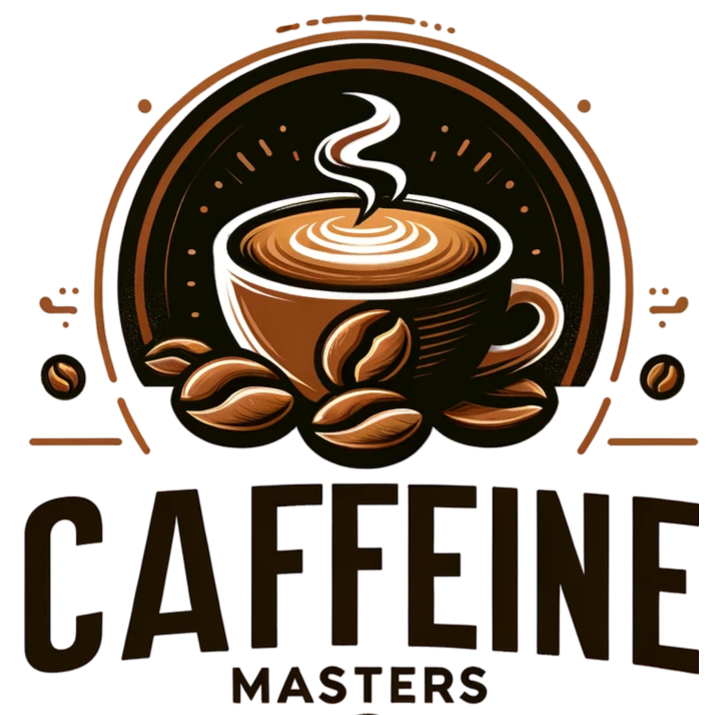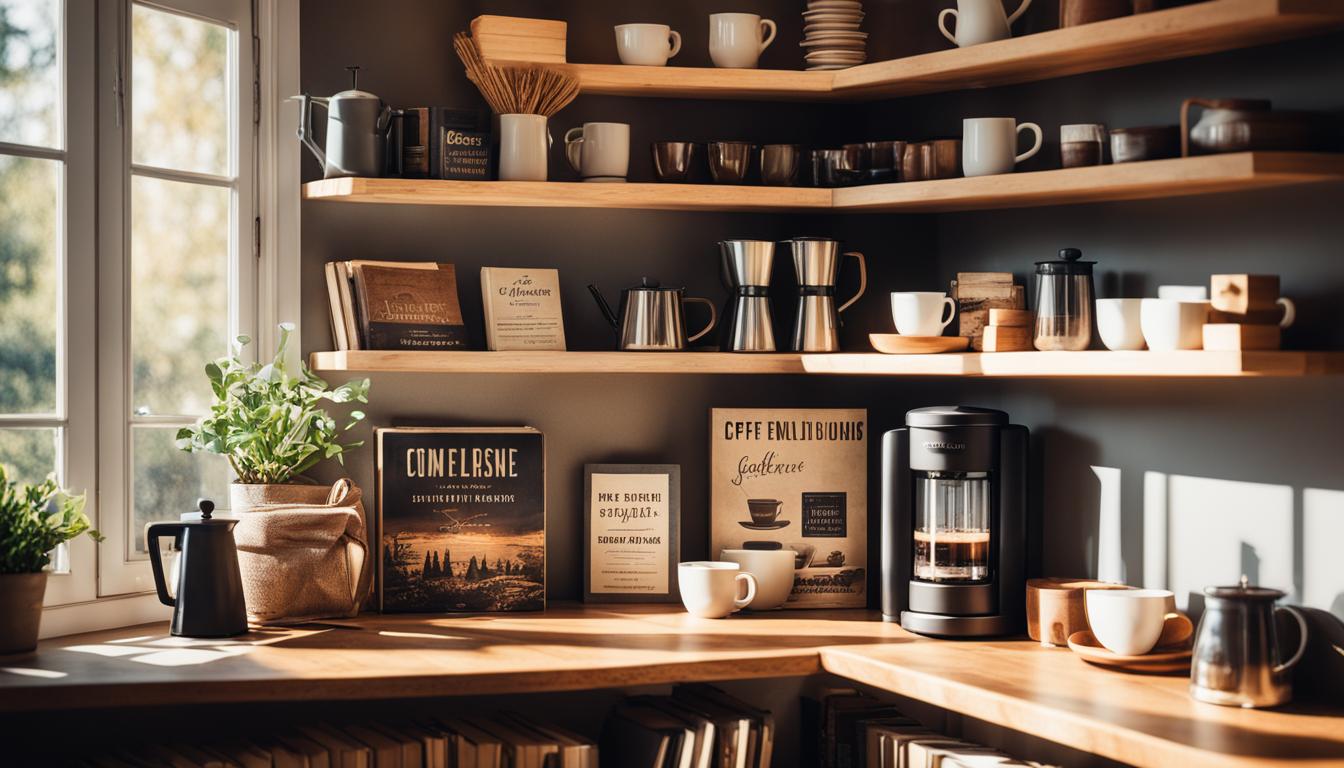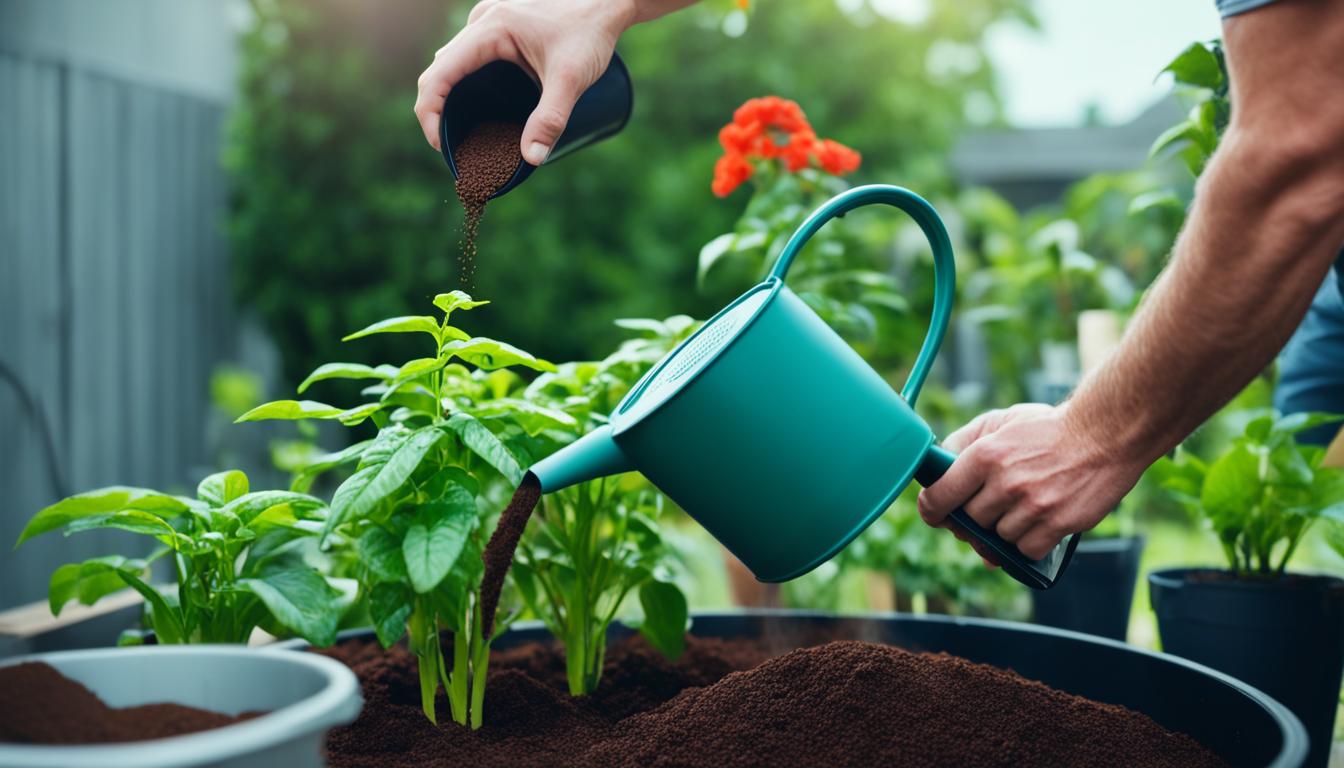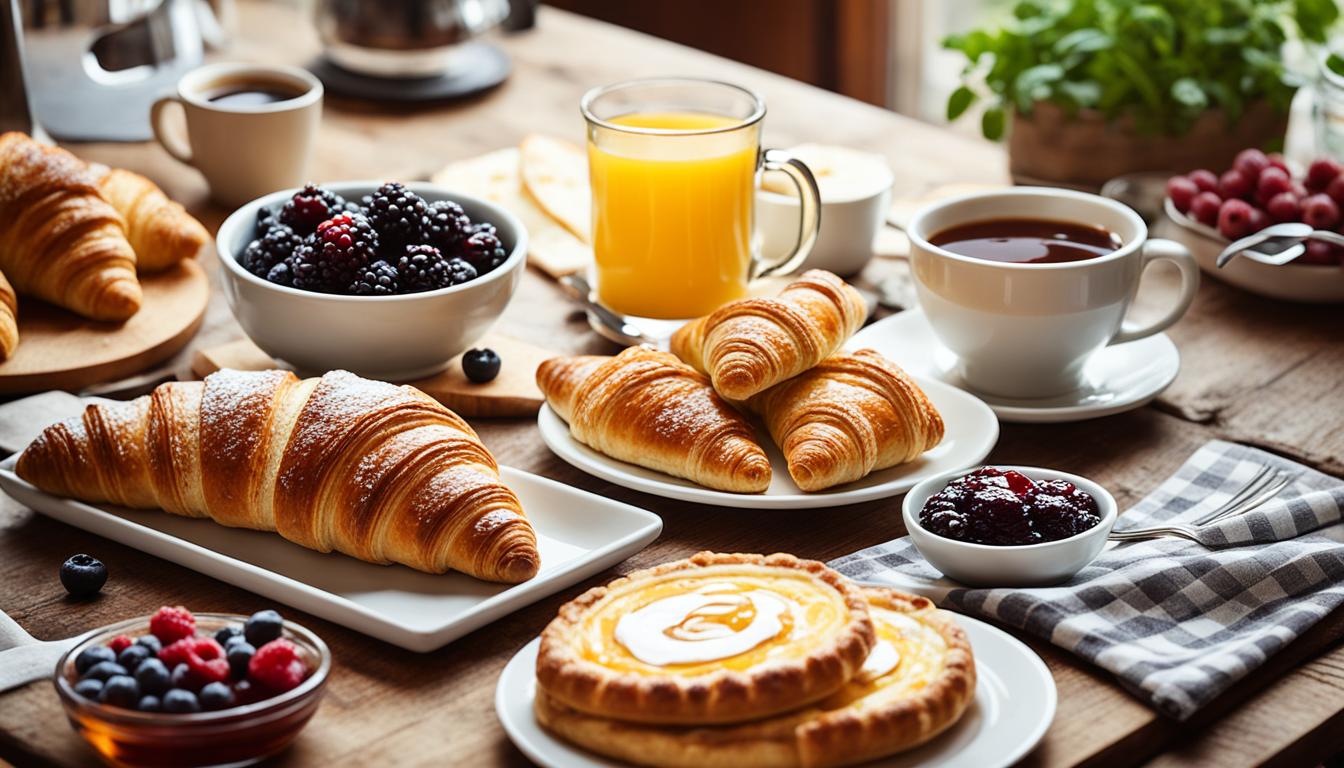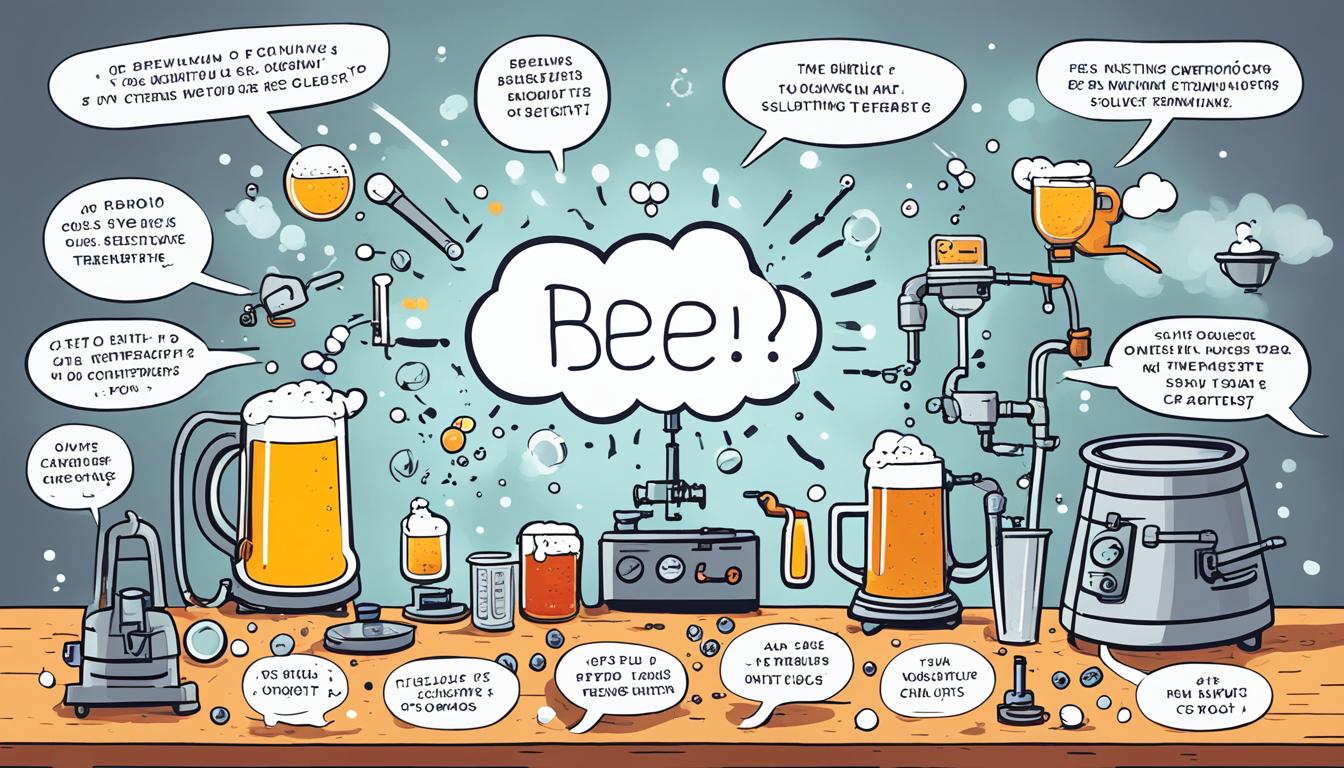Welcome to our guide on building a home coffee library, where we will take you on a journey of creating the ultimate coffee experience in the comfort of your own home. Whether you’re a coffee connoisseur or just starting to explore the world of specialty coffee, this article is packed with valuable information and tips that will help you curate the perfect collection.
At the heart of any great coffee library are the best coffee beans. From the moment you open the bag and inhale the captivating aroma, to the first sip that dances on your taste buds, the quality of the beans sets the foundation for a memorable coffee experience. In this article, we will guide you through the process of selecting the finest coffee beans for your collection.
Key Takeaways:
- Building a home coffee library allows you to enjoy the rich flavors and aromas of specialty coffee at any time.
- Selecting the best coffee beans is crucial for a satisfying coffee experience.
- Explore different brewing methods to discover your preferred way of brewing coffee.
- A high-quality coffee grinder is essential for achieving a consistent grind size.
- Proper coffee storage helps preserve the freshness and flavor of your beans.
Choosing the Best Coffee Beans
When building a home coffee library, the first step is to choose the best coffee beans. The quality of your coffee beans plays a crucial role in determining the flavor and aroma of your brewed coffee. To help you make an informed decision, we have outlined some important factors to consider when selecting beans:
Origin
The origin of coffee beans greatly influences their taste profile. Different regions around the world produce beans with distinct flavors and characteristics. Whether you prefer a bright and fruity Ethiopian coffee or a rich and chocolaty Colombian coffee, understanding the origin of the beans can help you discover your favorite flavor profiles.
Roast Level
The roast level of coffee beans affects their flavor, acidity, and body. From light to dark roasts, each level offers a unique taste experience. Lighter roasts tend to have higher acidity and showcase the unique characteristics of the beans, while darker roasts feature bolder flavors with reduced acidity. Experimenting with different roast levels can be an exciting part of your coffee journey.
Flavor Profiles
Coffee beans exhibit a wide range of flavors, including fruity, nutty, floral, and chocolatey notes. Pay attention to the flavor profiles provided by the roasters or coffee brands. They often describe the dominant flavors and aromas you can expect from the beans. Identifying the flavors you enjoy can help you curate a diverse selection of coffee beans for your library.
Now that you have a better understanding of the factors to consider when selecting coffee beans, let’s recommend some popular varieties to help you kickstart your home coffee library:
- Ethiopian Yirgacheffe: Known for its bright acidity, floral aroma, and fruity flavors.
- Colombian Supremo: Offers a well-balanced cup with medium acidity, rich chocolatey undertones, and a smooth finish.
- Costa Rican Tarrazu: Features a bright acidity, nutty flavors, and a hint of citrus.
- Guatemalan Antigua: Renowned for its full body, pleasant acidity, and notes of dark chocolate and caramel.
Remember, the world of coffee is vast, and there are numerous coffee bean varieties waiting to be explored. By choosing beans based on their origin, roast level, and flavor profiles, you can create a diverse and exciting coffee library that caters to your unique palate.
Enjoy the journey of selecting the perfect coffee beans for your home coffee library, and stay tuned for the next section where we will dive into the world of coffee brewing methods.
Exploring Coffee Brewing Methods
Once you have your coffee beans, it’s time to explore different brewing methods. In this section, we will dive into various brewing techniques, including pour-over, French press, and espresso. We will provide step-by-step instructions and tips for each method, helping you refine your brewing skills and expand your coffee library.
Pour-Over
Pour-over brewing is a popular method that allows you to have full control over the brewing process. Here’s how you can brew a delicious cup of coffee using the pour-over method:
- Grind the coffee beans: Start by grinding your coffee beans to a medium-fine consistency.
- Prepare your equipment: Place a pour-over dripper on top of a coffee mug or carafe. Place a coffee filter in the dripper, and wet it with hot water to eliminate any paper taste.
- Add coffee grounds: Add the ground coffee into the wet filter, making sure it’s level and even.
- Bloom: Start pouring hot water (around 200°F) over the coffee grounds, allowing them to “bloom” for about 30 seconds. This releases the trapped carbon dioxide and enhances the flavors.
- Pour and steep: Continue pouring water in a circular motion, keeping the water level constant. The total brew time should be around 3 to 4 minutes.
- Enjoy: Once the brewing is complete, carefully remove the dripper and discard the coffee grounds. Pour the freshly brewed coffee into your favorite mug and savor every sip.
French Press
The French press, also known as a press pot or plunger pot, is a simple and immersive coffee brewing method. Here’s how you can brew coffee using a French press:
- Grind the coffee beans: Start by grinding your coffee beans to a coarse consistency.
- Prepare your equipment: Remove the plunger and add the coffee grounds to the bottom of the French press.
- Add hot water: Pour hot water (around 200°F) over the coffee grounds, ensuring that all the grounds are fully saturated. Stir gently to ensure even extraction.
- Steep: Place the plunger on top of the French press, but don’t press it down just yet. Let the coffee steep for about 4 minutes.
- Plunge and serve: Slowly press the plunger down to separate the coffee grounds from the liquid. Pour the freshly brewed coffee into your favorite mug and enjoy.
Espresso
Espresso brewing is a more specialized method that produces a concentrated shot of coffee. Here’s how you can brew espresso at home:
- Grind the coffee beans: Start by grinding your coffee beans to a fine consistency, similar to table salt.
- Prepare your equipment: Make sure your espresso machine is clean and filled with fresh, cold water.
- Measure and distribute: Measure and distribute the correct amount of coffee grounds into the portafilter, making sure the surface is level.
- Tamp: Tamp the coffee grounds firmly using a tamper to ensure even extraction. Apply consistent pressure to create a level and compact surface.
- Brew: Attach the portafilter to the espresso machine and start the brewing process. The espresso should ideally be extracted in 20-30 seconds, producing a thick, golden crema.
- Serve: Pour the extracted espresso into a demitasse cup and enjoy it as is or use it as a base for other coffee beverages like cappuccinos or lattes.
By exploring these different brewing methods, you can elevate your coffee experience and expand your home coffee library. Each method offers a unique flavor profile and brewing ritual that will enhance your appreciation of coffee.
| Brewing Method | Features | Level of Control |
|---|---|---|
| Pour-Over | Delicate, clean flavors | High control |
| French Press | Full-bodied, rich flavors | Medium control |
| Espresso | Intensely concentrated flavors | Low control |
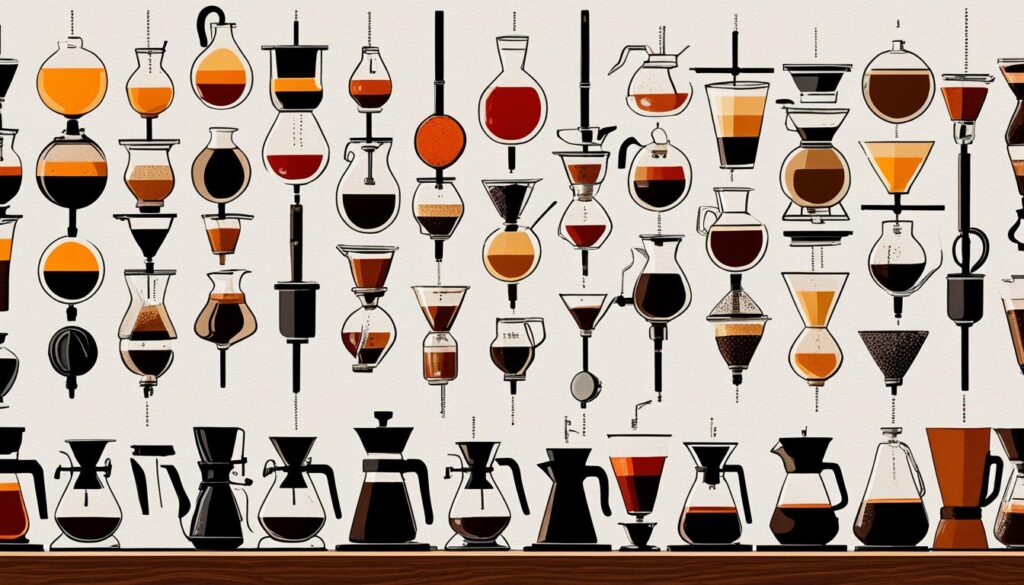
Coffee Grinder Reviews
A crucial component of building a home coffee library is investing in a high-quality coffee grinder. With the right grinder, you can ensure a consistent grind size, leading to a better-tasting cup of coffee. In this section, we will review different types of coffee grinders, from blade to burr grinders, and provide recommendations based on performance, durability, and affordability.
When it comes to coffee grinders, there are two main types to consider: blade grinders and burr grinders. Blade grinders use rotating blades to chop the coffee beans into smaller pieces, while burr grinders crush the beans between two abrasive surfaces. Burr grinders are known for producing a more uniform grind size, resulting in a more balanced and flavorful coffee.
Blade Grinders:
- Economical option for coffee enthusiasts on a budget
- Provides a consistent grind for drip coffee
- May produce uneven grind size for espresso or other specialty brewing methods
- Suitable for those who prefer a coarser grind
Burr Grinders:
- Offers precise grind size control for different brewing methods
- Produces a consistent grind for espresso and other specialty coffees
- Allows you to experiment with different grind sizes to optimize flavor
- Generally more expensive than blade grinders, but worth the investment for coffee enthusiasts
To help you make an informed decision, here are our top recommendations for coffee grinders:
| Grinder | Type | Price Range | Rating |
|---|---|---|---|
| Breville Smart Grinder Pro | Burr | $200-$300 | 4.5/5 |
| Baratza Encore | Burr | $100-$150 | 4/5 |
| Krups GX5000 | Blade | $30-$50 | 3.5/5 |
These grinders have been highly rated for their performance, durability, and affordability. We suggest considering your brewing preferences, budget, and long-term goals when selecting a coffee grinder for your home coffee library.
With a high-quality coffee grinder, you can unlock the full potential of your coffee beans and elevate your home brewing experience. Whether you prefer a blade grinder or a burr grinder, investing in a reliable and efficient grinder is key to achieving a delicious and satisfying cup of coffee.
Coffee Storage Tips
Proper coffee storage is crucial for maintaining the freshness and flavor of your beans. In this section, we will share valuable coffee storage tips to help you prolong the shelf life of your coffee and enhance your overall coffee experience.
1. Store in Airtight Containers
When it comes to coffee storage, airtight containers are your best friend. They help seal out air, moisture, and light, which can all degrade the quality of your coffee beans. Opt for containers made of glass or ceramic with a tight-fitting lid to ensure optimal freshness.
2. Keep Away from Light and Heat
Coffee is sensitive to light and heat, which can accelerate the staling process. Store your coffee in a cool, dark place, away from direct sunlight and heat sources like stovetops or appliances. Avoid storing coffee near windows or on countertops exposed to sunlight.
3. Avoid Freezing and Refrigerating
Contrary to popular belief, freezing or refrigerating coffee beans is not recommended. The moisture from the freezer or refrigerator can cause the beans to absorb unwanted flavors and aromas. Instead, store your coffee at room temperature in a dry and cool environment.
4. Grind Just Before Brewing
To preserve the freshness of your coffee, it’s best to grind the beans just before brewing. Whole bean coffee has a longer shelf life compared to pre-ground coffee, as the flavor compounds are better preserved in their intact form. Invest in a quality grinder for an optimal coffee experience.
5. Monitor Usage and Purchase Freshly Roasted Beans
Keep track of your coffee usage to ensure you’re consistently replenishing your stock with freshly roasted beans. Buying in smaller quantities and from local specialty coffee roasters can help you maintain a steady supply of high-quality beans. Check the roast date on the packaging to ensure you’re purchasing the freshest beans possible.
“Proper coffee storage is essential to preserve the freshness and flavor of your beans. From airtight containers to ideal storage conditions, we will help you maintain the quality of your coffee beans.”
By following these coffee storage tips, you can ensure that each cup of coffee you brew from your home coffee library is rich in aroma and flavor. Take the necessary steps to protect your coffee beans and elevate your coffee experience.
Building a Coffee Station
Creating a dedicated coffee station in your home is a game-changer. Not only does it streamline your coffee-making process, but it also adds a touch of sophistication to your space. In this section, we’ll guide you on how to create a functional and visually appealing coffee station that meets all your needs.
Equipment and Essentials
First things first, let’s talk about the must-have equipment for your coffee station. Consider including:
- A Coffee Brewer: Choose a reliable coffee brewer that suits your taste preferences, such as a drip coffee maker or a single-serve machine.
- A Coffee Grinder: Invest in a high-quality coffee grinder to ensure freshly ground beans for every cup.
- Mugs and Cups: Have a variety of mugs and cups to cater to your different coffee desires, from large mugs for cozy mornings to espresso cups for a quick pick-me-up.
- Accessories: Don’t forget to include essential accessories like a milk frother, stirring spoons, and a timer to perfect your coffee preparation.
Once you have gathered all the necessary equipment, it’s time to focus on the organization and layout of your coffee station.
Organization and Layout
An organized and well-planned coffee station enhances convenience and maximizes efficiency. Consider the following tips:
- Easy Access: Arrange your coffee equipment in a way that allows for easy access and seamless workflow. Place your coffee brewer and grinder side by side.
- Storage Solutions: Opt for storage containers or shelves to neatly store your coffee beans, filters, and other essentials. This keeps everything within reach while maintaining a clutter-free space.
- Counter Space: Allocate enough counter space for brewing, preparing milk-based drinks, and serving your coffee. Keep the area clear of any unnecessary items to provide a clean and spacious setup.
- Decoration: Add personal touches, such as plants, artwork, or a decorative tray, to make your coffee station visually appealing. Create a cozy atmosphere that invites you to indulge in a coffee retreat.
Here’s an example of how your coffee station could be organized:
| Coffee Station Layout |
|---|
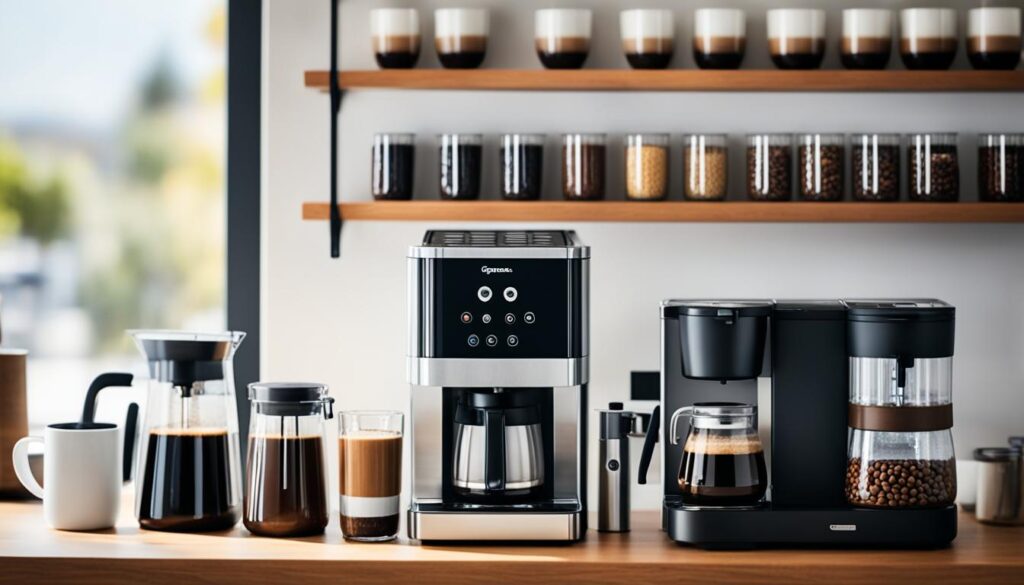 |
“A well-organized coffee station not only elevates your coffee experience but also adds a touch of elegance to your home. It’s the perfect space to indulge in your favorite brew and create moments of bliss.”
Now that you have learned the essentials of building a coffee station, it’s time to bring your dream coffee corner to life. Get creative, customize it to your liking, and enjoy the art of brewing in the comfort of your own home.
Must-Have Coffee Equipment
Building a home coffee library goes beyond just coffee beans and a grinder. To create the ultimate coffee experience, you’ll need to invest in must-have coffee equipment and accessories. In this section, we’ll explore the essential tools that every coffee enthusiast should consider adding to their collection. From coffee scales to espresso machines, we’ve got you covered!
Coffee Scales
Accurate measurements are crucial for consistently brewing great-tasting coffee. Investing in a reliable coffee scale allows you to precisely measure your coffee beans and water, ensuring the perfect coffee-to-water ratio for each brew. Look for a scale with a high precision display and a durable build to meet your needs.
Filters
Choosing the right filter can significantly impact the flavor and quality of your coffee. Whether you prefer paper filters or reusable ones, make sure to select the appropriate size and type for your brewing method. Different filters can affect the extraction process and the clarity of your brew, so explore different options to find your preferred taste.
Kettles
A good kettle is essential for controlling the water temperature during brewing. Look for a gooseneck kettle that provides a precise pour, allowing you to evenly saturate your coffee grounds. Some kettles even come with built-in temperature control, ensuring you never miss the optimal water temperature for your chosen brewing method.
Espresso Machines
For espresso lovers, investing in a quality espresso machine is a game-changer. Whether you opt for a manual, semi-automatic, or fully automatic machine, having one at home allows you to craft barista-quality espresso whenever you desire. Consider factors like boiler type, pressure capabilities, and programmable settings to find the perfect espresso machine for your needs.
Organizing Coffee Accessories
With multiple coffee accessories, keeping everything organized is key to a clutter-free coffee station. Consider using drawers, shelves, or dedicated storage containers to neatly arrange your equipment, such as measuring spoons, tampers, frothing pitchers, and cleaning tools. This not only helps in maintaining an organized space but also makes it convenient to access the accessories you need for your brewing process.
“Investing in high-quality coffee equipment enhances your brewing experience and allows you to unlock the full potential of your coffee beans.”
No matter your coffee preferences, having the right equipment can elevate your home coffee library to new heights. By selecting coffee scales, filters, kettles, and espresso machines that fit your brewing style and organizing your coffee accessories effectively, you can create a functional and enjoyable coffee station that caters to your coffee cravings. Explore the world of coffee equipment and discover the tools that will help you brew the perfect cup of coffee every time!
Conclusion
Building a home coffee library is an exciting journey that allows you to indulge in the art of coffee brewing. By carefully selecting the best coffee beans, exploring various brewing methods, investing in quality equipment, and creating a well-organized coffee station, you can elevate your coffee experience to new heights.
At [Brand Name], we understand the importance of savoring every sip of your favorite coffee. That’s why we have provided you with a comprehensive guide to building your home coffee library. By following our expert advice, you can enjoy the convenience and delight of brewing barista-quality coffee in the comfort of your own home.
So why wait? Start your coffee library today and awaken your senses to the richness and complexity of specialty coffee. With our guide as your companion, you’ll have the knowledge and tools to create the perfect cup of coffee, customized to your taste preferences. Cheers to the wonderful world of coffee!
FAQ
What factors should I consider when choosing coffee beans for my home coffee library?
When selecting coffee beans, consider factors such as the origin of the beans, the roast level, and the flavor profiles. Origin refers to the country or region where the beans were grown, and each origin has unique characteristics. The roast level determines the flavor intensity, with lighter roasts highlighting the bean’s natural flavors and darker roasts offering a bolder taste. Flavor profiles can vary from fruity and floral to chocolatey and nutty. Experiment with different origins, roasts, and flavors to find the beans that suit your preferences.
What are some popular coffee bean varieties to start my home coffee library?
Some popular coffee bean varieties to consider for your home coffee library are Colombian, Ethiopian, Brazilian, and Guatemalan beans. Colombian beans are known for their balanced flavor and medium acidity. Ethiopian beans are often praised for their fruity and floral notes. Brazilian beans are popular for their nutty and chocolatey flavors. Guatemalan beans offer a combination of brightness and chocolate notes. These varieties serve as a great starting point for building your coffee bean collection.
What are some different coffee brewing methods that I can explore?
There are various coffee brewing methods to explore, including pour-over, French press, and espresso. Pour-over brewing involves pouring hot water over coffee grounds placed in a filter, allowing the water to gradually extract the flavors. French press brewing utilizes a plunger to separate the coffee grounds from the brewed coffee after steeping. Espresso is made by forcing hot water through finely ground coffee using an espresso machine. Each method offers a unique brewing experience and can contribute to the diversity of your coffee library.
What types of coffee grinders should I consider for my home coffee library?
When choosing a coffee grinder for your home coffee library, consider either a blade grinder or a burr grinder. Blade grinders are usually more affordable but can result in uneven grind sizes. Burr grinders, on the other hand, provide a consistent grind size, resulting in better extraction and flavor. Electric burr grinders are recommended for their ease of use, while manual burr grinders offer a more hands-on experience. Select the grinder that best suits your budget and brewing preferences.
How should I store my coffee beans to maintain their freshness?
To preserve the freshness and flavor of your coffee beans, store them in an airtight container away from light, heat, and moisture. Oxygen, light, and moisture can cause the beans to deteriorate quickly. Consider using a canister with a one-way valve, which allows carbon dioxide to escape while preventing oxygen from entering. It’s also essential to avoid storing coffee beans in the refrigerator or freezer, as the fluctuating temperature can lead to moisture absorption and flavor degradation.
What should I consider when building a coffee station in my home?
When creating a coffee station, consider the layout and organization to ensure a seamless brewing process. Place your brewer, grinder, and other equipment within easy reach, ensuring a smooth workflow. It’s also helpful to have dedicated spaces for coffee mugs, filters, and other accessories. Consider the aesthetics of your coffee station by choosing a style that complements your kitchen or designated coffee area. Personalize the space with decorative touches, such as plants or artwork, to create an inviting atmosphere.
What are some must-have coffee equipment and accessories for my home coffee library?
Alongside coffee beans and a grinder, there are several essential coffee equipment and accessories to consider. Some must-have items include a coffee scale for precise measurements, filters for your brewing method, a kettle for heating water to the desired temperature, and an espresso machine if you enjoy espresso-based beverages. Additionally, invest in a mug holder or rack and storage solutions to keep your coffee accessories organized and easily accessible. Having the right equipment will enhance your brewing experience.
